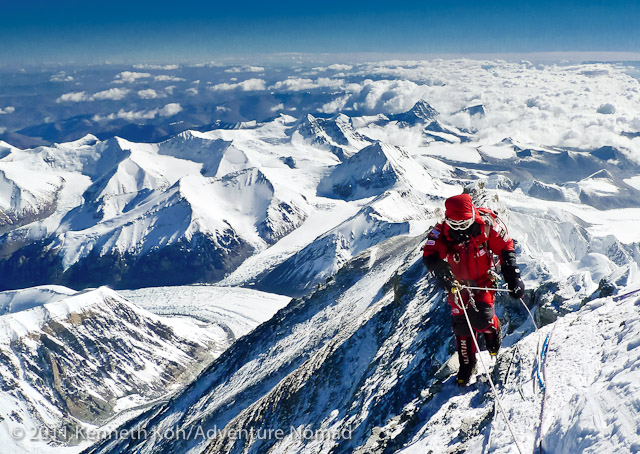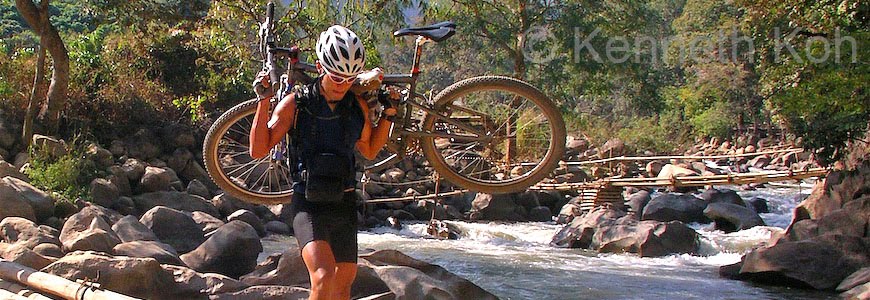 |
| Sunrise at 8500m on the North Ridge of Everest. Photo by Jamling Bhote. |
1. Weigh The Risks
Climbing Everest is not that difficult technically, but it is one of the more risky climbs you can do. Despite improvements in equipment and weather forecasting, someone dies on Everest every year. Last year, there were 131 summits from Tibet (where I also summitted) with 1 death, and 277 summits from Nepal with 2 deaths. You need to think this over, and maybe talk it over with your family.
 |
| At 8700m on the way to the summit. Photo by Jamling Bhote. |
Climb everything: rock, snow, ice. Learn to move efficiently over different terrain and conditions with a heavy pack, boots and crampons. Get used to clipping into and out of anchors and ropes. Learn to work a jumar ascender until it becomes second nature: on summit day, you will be doing this with very little oxygen, little sleep, and with bulky gloves or mittens on.
3. Find Sponsors
Climbing Everest is an expensive venture. Today, it will cost about USD$40,000 - $60,000 (excluding equipment and training), depending on the logistics provider you choose and whether you decide to climb via the North (Tibet) or South (Nepal). Ideally, you can pay for this yourself. If not, the search for sponsors can take some time, and it would be best to start this process early.
 |
| Our little group (Jamling, me and Pujung) 30 minutes from the summit. Photo by Kaji Sherpa. |
Get advice from other summiteers on who the best personal sherpas are, find one, and book him early. A good personal sherpa will ensure that the hundred and one things to take care of on your summit bid (oxygen, food, etc) are taken care of, and be a reassuring pillar of strength as you climb above and beyond your previous limit. I used Jamling Bhote (jamlinglama@yahoo.com), a 7-time Everest summiteer, and booked him a year in advance. During my summit bid, I had some reservations as we were climbing in brutally cold and windy conditions. I didn't have 8000m experience, or a guide, and so I looked to Jamling for guidance. Jamling confidently told me that it was just a normal day on Everest. We pushed on and made the summit an hour and half later in improving conditions.
4. Specific 8000m Experience
Beyond building general climbing experience, you should also test yourself and your equipment on an 8000m peak. You also get to become familiar with using oxygen systems. Cho Oyu is a great mountain to build 8000m experience, and the main climbing season is in Autumn, about six months prior to the typical Spring season on Everest.
6. Equipment
Buy the best best and the warmest gear you can afford. In good conditions, you can summit in almost anything, but when conditions aren't ideal, you may still be able to summit in warmer gear. For example, use a one-piece down suit and not a two-piece. The one-piece will be lighter and warmer. Similarly, buy and use the best and warmest boots, preferably relatively new, and not some 5-year old borrowed boots. I used the Millet Everest boot, which are supposed to be the warmest of the high altitude boots. My toes were freezing, and if not for the chemical toe warmers inside, I doubt that I would have summited.
7. Training
There's a difference between building experience and training. Think of building experience as an ongoing process of accumulating knowledge which can take many years, and training as physical preparation which covers several months leading up to an expedition.
There are 2 main types of training you need to do: Sport Specific and General Physical Preparedness (GPP). Sport specific training should form the bulk of your training, and for mountaineering, it is simply doing a lot of mountaineering, or if you can't get out to the mountains, it can be done by carrying a heavy pack plus ankle weights (to simulate the weight of boots and crampons) and walking up and down hills or stairs. GPP is training for any and all contingencies. For example, walking up and down stairs won't necessarily give you the ability to jump over crevasses, sprint for cover, or move heavy loads of expedition gear. You'll need to do some other type of training, and the best I've come across for this sort of thing is CrossFit. If you're not familiar with CrossFit, think of it as gym work on crack. It combines Olympic weightlifting, gymnastics and cardio into a short, intense session.
 |
| CrossFit at CrossfitSG.com. Photo by Laura Liong. |
I bought a used hypoxic generator which removes oxygen from the air you breathe. There are several different ways to train with this device, and I used them all. One of the ways is to sleep in it. I spent the six months leading up to my Everest expedition sleeping inside an oxygen deprived tent (on the floor with a thermarest and sleeping bag). It aids acclimatization during the early stages of the expedition, keeping nausea and headaches at bay and allowing you to eat and sleep better, giving you a head start in staying healthy.
 |
| Hypoxic training at '4,800m'. Doggies on the bed, I sleep in the tent on the floor. Photo by Laura Liong. |
Everest is a two-month long expedition, but it all boils down to the seven-days of your summit bid. If you fall sick (catch an infection or get a stomach bug), you risk losing your chance for the summit. You need to eat well, ensuring adequate protein intake, which could be difficult. I brought a Meal Replacement Powder (MRP), and it was useful at the higher camps for the times when I couldn't eat solid food. Fresh produce may not be readily available, and I chose to supplement my diet with fish oil, probiotics and a multi-vitamin. Jamling and I also used Silver Sol, a broad spectrum microbial (kills bacteria, viruses, and fungus) throughout the expedition. I also used a Totobobo Anti-Pollution Face Mask during the drive in to basecamp. Some links below if you want to buy any of this stuff.
10. Actively Seek Advice
There are not that many people that have climbed Everest (By being the last to summit in Spring '11, I became the 3436th person to summit). Still, you can find useful information online. Alan Arnette and Project Himalaya are a couple of good websites to start with, and eventually, I climbed Everest with Project Himalaya. I'm also lucky that a few of my friends have also summited Everest. They were my inspiration to climb Everest, and also an unlimited source of information.
There you have it. Best of luck!
 |
| The Summit... Yay! Image taken off video captured by Jamling Bhote. |
Now Foods Super EPA Fish Oil
Now Foods GR8 Dophilus Probiotics
Now Foods Adam Multi Tablet
Silver Biotics (Silver Sol)
BSN Syntha-6 Vanilla Ice Cream MRP
If you order any of the above from iHerb, please use discount code KOH756 to get $5 off your first order (I get 2% of the sale too - Woohoo!)
Totobobo Anti-Polution Facemask - Use discount code adventurenomad at checkout to get a discount.
